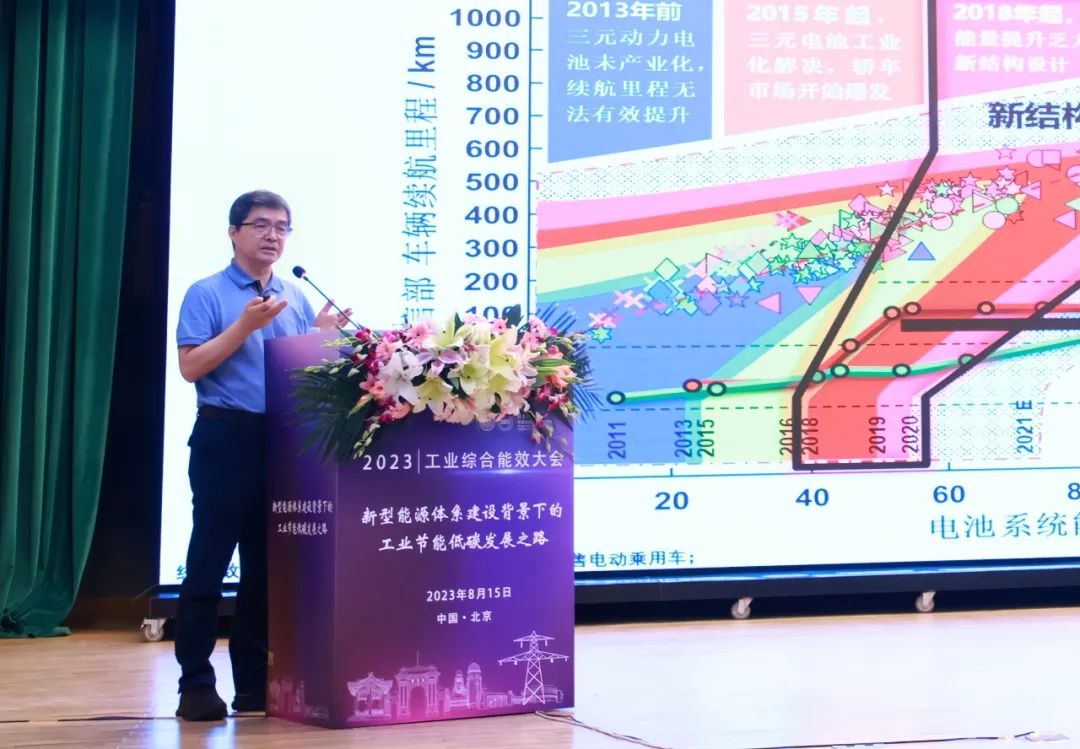1. The future will see boom in new energy vehicles by over 10 million vehicles every year, which also highlights the issue of the convenience of charging, as well as the load increment brought to the grid by electric vehicle charging. It is therefore necessary to consider the interaction and synergy between new energy electricity and new energy power.
2. According to Ouyang Minggao, solution to these problems requires the establishment of a broadly defined intelligent energy system, such as vehicle-grid interaction.
China Star Market Daily, August 16 (Li Mingming): With the rapid development of China's electric vehicle industry, the attribute of on-board power batteries as electrical energy storage devices has also received increased attention. The concept of vehicle-grid interaction has also been a frequented topic of discussion.
On August 15, the 2023 Industrial Comprehensive Energy Efficiency Conference was held in Beijing, jointly organized by Tsinghua University's Energy Internet Research Institute and the China Association for Industrial Energy Conservation and Clean Production, to facilitate collaboration in research and promotion of the dual enhancement of industrial energy efficiency and carbon efficiency.
Ouyang Minggao, academician of Chinese Academy of Sciences, professor and doctoral supervisor of School of Vehicles and Transportation, Tsinghua University, attended the meeting and made a keynote speech on "New Energy Power and New Energy Electricity - Prospect of Electric Vehicles’ Vehicle-Grid Activity and Intelligent Energy System", which depicted the broad prospect of the integration and development of new energy vehicles and new electric power systems from the perspective of the carbon peak and neutrality targets, and focused on the feasibility and advantages of implementing vehicle-grid interaction in China.

He pointed out that China's new energy sector is facing a myriad of challenges along with unprecedented development; China's renewable power installed increment, photovoltaic shipments accounted for 70% of the world; however, due to instability of the wind and light resources, it is difficult to balance supply and demand, and the power system is facing major challenges. Also, in terms of new energy power, or the load side, China continues to achieve breakthroughs in power battery technologies, and new energy vehicle sales now lead the world at the top.
Photovoltaic, battery and new energy vehicles are now the new three economic pillars of China's exports. In the future, more than 10 million new energy vehicles will be added every year, which also highlights the problem of the convenience of charging, as well as the incremental load that electric vehicle charging brings to the power grid. It is therefore necessary to consider the interaction and synergy of new energy electricity and new energy power.
Ouyang Minggao believes that the solution to the above problems requires the establishment of a broadly defined intelligent energy system, such as vehicle-grid interaction, which takes electric vehicles as its core, combines with energy Internet technology, and turns into an energy terminal with energy use and storage back to the energy terminal. Moreover, vehicle-grid interaction has important strategic significance and is the focus of global competition for new energy vehicles. Therefore, it is necessary to promote two-way energy interaction between electric vehicles and smart grids, and to develop a long-term work plan and strategy for vehicle-grid integration.
It is understood that the concept of vehicle-grid interaction was put forward a long time ago. In 2020, vehicle-grid interactive charging piles were piloted in the Sino-Singapore Tianjin Eco-city "Huifengxi" intelligent energy town construction.
In March this year, the first "White Paper on Scale Application and Development of Vehicle-Grid Interaction" was released in Shenzhen. The paper details the demand and motivation for vehicle-grid interaction of scale, the differentiated requirements of the participants, the relationship between supply and demand, and the profit model, as well as the major bottlenecks of vehicle-grid interaction of scale, and the synergistic development of vehicle-grid interaction of scale.
In April this year, Zhu Gongshan, Chairman of GCL Group, also proposed at the China EV 100 Forum that, through V2G technology and coordinated charging technology, electric vehicles can be turned into controllable distributed energy storage that charges during low-cost electricity and non-peak hours, and electricity can be sold back to the grid during peak hours.
Ouyang elaborated on the advantages of vehicle-grid interaction as a key path to solving charging capacity. “Uncoordinated charging is unsustainable and can have a catastrophic impact on the grid. EVs can charge during the low valleys and interact with the supply side in both directions. This not only ensures coordination, but also EVs can become an energy storage device to provide energy for the city to accommodate more renewable energy and rechargeable photovoltaics. A broadly defined vehicle-grid interaction will make EV charging free, and even make EVs a money maker. We have already done a related demonstration at the Institute of Automotive Research, and the results are exceptionally good. Participation of the government, enterprises, and users alike are needed to build an energy Internet platform.”
He went on with an outlook of low-cost, large-scale vehicle-grid interaction geared toward carbon neutrality. In the next decade, electric vehicles and smart energy are expected to reach a trillion-dollar industry scale. The golden combination encompasses distributed photovoltaic + battery storage + vehicle network interaction + Internet + blockchain. By 2030, the photovoltaic industry will exceed one billion kilowatts, and the number of electric vehicles will enter the era of 100 million. By 2060, it is expected to enter the era of 10 trillion, and the installed wind power and photovoltaic capacity is expected to reach 6 billion kilowatts.
Ouyang Minggao listed some demonstration projects developed with vehicle-grid interaction, including the new-generation low-carbon field station intelligent energy management solution in Tianjin, the intelligent low-carbon industrial carbon park in Yiwu, Aixu integrated photovoltaic plant of light, storage, charging and discharging in Foshan, the scaled-up V2G demonstration of electric vehicles in Shenzhen, and the Toyota Park microgrid in the model of light, storage and hydrogen + vehicle-grid interaction + power trading in Shanghai, amongst others.